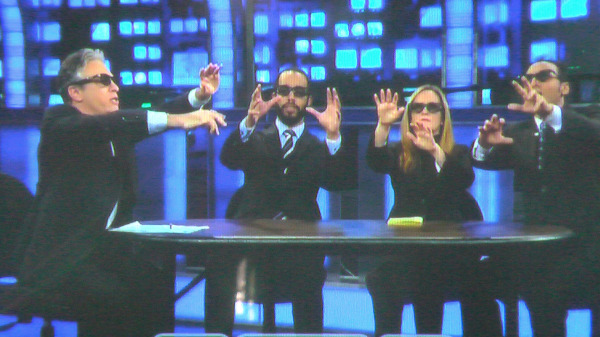James Cameron can do eye-popping 3D. He did it with his groundbreaking Universal Studios 3D theme park attraction “T2 3D.”

That’s the kind of push-out 3D most people think about when they think of 3D. It’s why when John Stewart and Stephen Colbert are goofing on 3D, they put on glasses and put their hands out in the air in front of them, making believe they are trying to touch the images that appear to be right in front of their face.

Did you see a single person during your viewing of “Avatar” ever make that sort of gesture of wonderment while ooh-ing and ahh-ing? It happens for 40 solid minutes in the IMAX documentary “Under the Sea.” Audiences feel as if they are completely immersed in that underwater environment and as if the fish, plants and coral are inches from your face.
There were similar moments in “Journey to the Center of the Earth” and “The Final Destination 3D.”
But by and large, filmmakers of 3D movies of late are staying away from that level of 3D, opting to use the technology to draw viewers in rather than pushing out. I fear that it may be to the detriment of the format.

Cameron clearly made a conscious decision not to have 3D pop off the screen at all in “Avatar,” but simply provide a little more perception of depth to draw viewers in slightly without making them feel as if they are part of the experience. Some would argue that is enough, that 3D should not distract from the story, but simply enhance it subliminally by pulling you in a little bit more.
I suggest that if all movies and sporting events aggressively push the 3D off the screen and into our laps, that not only will that significantly increase the viewers’ feeling of immersion into the story or the event, but that very quickly it will cease being a distraction and become an accepted form of the experience.
Imagine feeling like you were actually walking through those “Avatar” forests, across those fallen trees and bridges, and being inside the aircraft or giant robots during the battle scenes. That’s not gimmickry and it’s not throwing spears in your face for a 3D effect; that’s using the technology to really draw the audience in to the experience to make us feel as if we are a part of the moment, that we are there on the sidelines or on the field at the football game. (The original giant-screen IMAX theaters such as the one at Universal CityWalk — not the new mini-IMAX theaters — offer the closest thing to this experience.)
Quite a few times during “Avatar” I noticed so little depth perception that I was distracted enough to repeatedly remove my glasses. I was surprised to see almost no difference, and certainly no blurring that typically occurs when there is image separation to create a greater 3D effect. That means the image was nearly flat, or 2D for much of the time. In fact, some prominent reviewers commented that the film might look nearly as good in 2D. Sure enough, a NYTimes.com science essayist raved breathlessly about the impact of the movie, having seen it initially only in 2D.
To me, that’s a shame, and a missed opportunity. At worst, if filmmakers continue to take this restrained, subtle approach to 3D as they have with most releases of the past couple years, it could really limit the revenue potential of the technology and especially the adoption of 3D in the home.
I know that sounds ridiculous to say when “Avatar” is breaking all box-office records around the globe. But right now 3D is a novelty, and “Avatar” has become a societal must-see movie regardless of technology or price, even for those who have little interest in it.
I wonder how many times the average moviegoer will be willing to fork over an extra $3, $5 or more per ticket to see the 3D version of a movie if it offers only a slightly increased perception of depth, sometimes so subtle that it’s barely noticeable or distinguishable when you lift your glasses.
Even more concerning, how many average consumers are going to pony up hundreds or thousands of dollars to upgrade their HiDef TVs and Blu-ray players to 3D if they get no more than slightly increased visual depth? At least with your new HDTV, you get a significantly wider screen in addition to the greatly improved image quality. That’s a tangible value, and even so it took many years before HiDef TVs are finally, and only recently, in a majority of homes.
People should be coming out of a movie like “Avatar” wowed by the 3D and ready to go see whatever is next in 3D, just because the 3D is that dynamic and exciting. How many people did you hear talking about the 3D in “Avatar” that way? Or at all?
For a movie designed as a breakthrough in the use of 3D that has become the second biggest movie of all time, shouldn’t 3D be a primary element of the conversation?
The best gauge is the number of people you see during the movie raising their hands to try to touch something in front of their face that isn’t there. That’s the wonder that should illustrate and define 3D.

Hey Scott,
I too want the satisfaction of having to refocus in and out of the window, but if I come across a scene that lacks pop, it’s not the cameras that need to be set further apart- it’s that content creators just need to add something, anything, into the foreground. For instance, if you’re looking out the window of an airplane, you’d want a wing or propeller or something in sight with the clouds, earth and water mostly looking flat. 3D works best within a 15-20 foot radius in real life.
I think 2D>3D will be similar to SD>HD: there will be those who complain that the difference isn’t big enough, and then there will be temptation for the cinematographers to use wider lens spacing at the cost of criticism from the enthusiasts who will say it doesn’t look natural anymore.